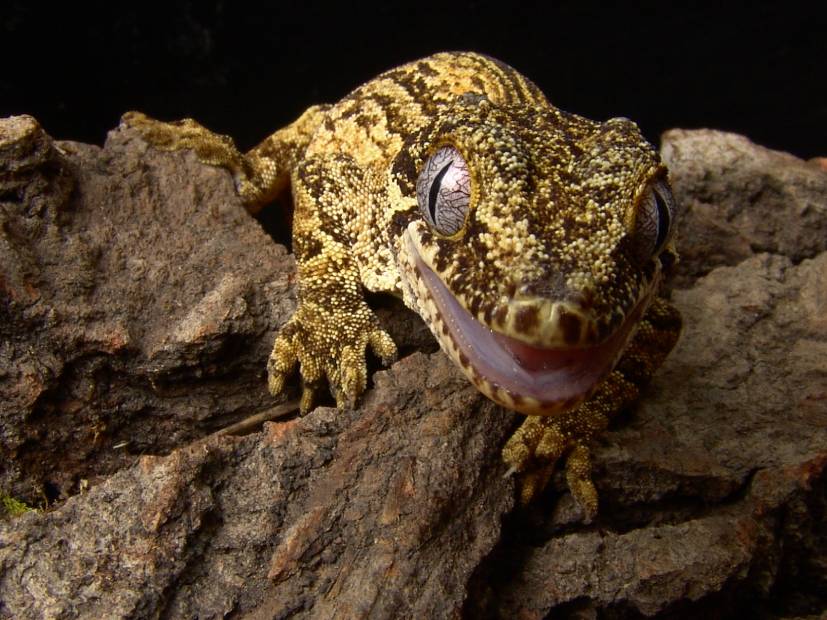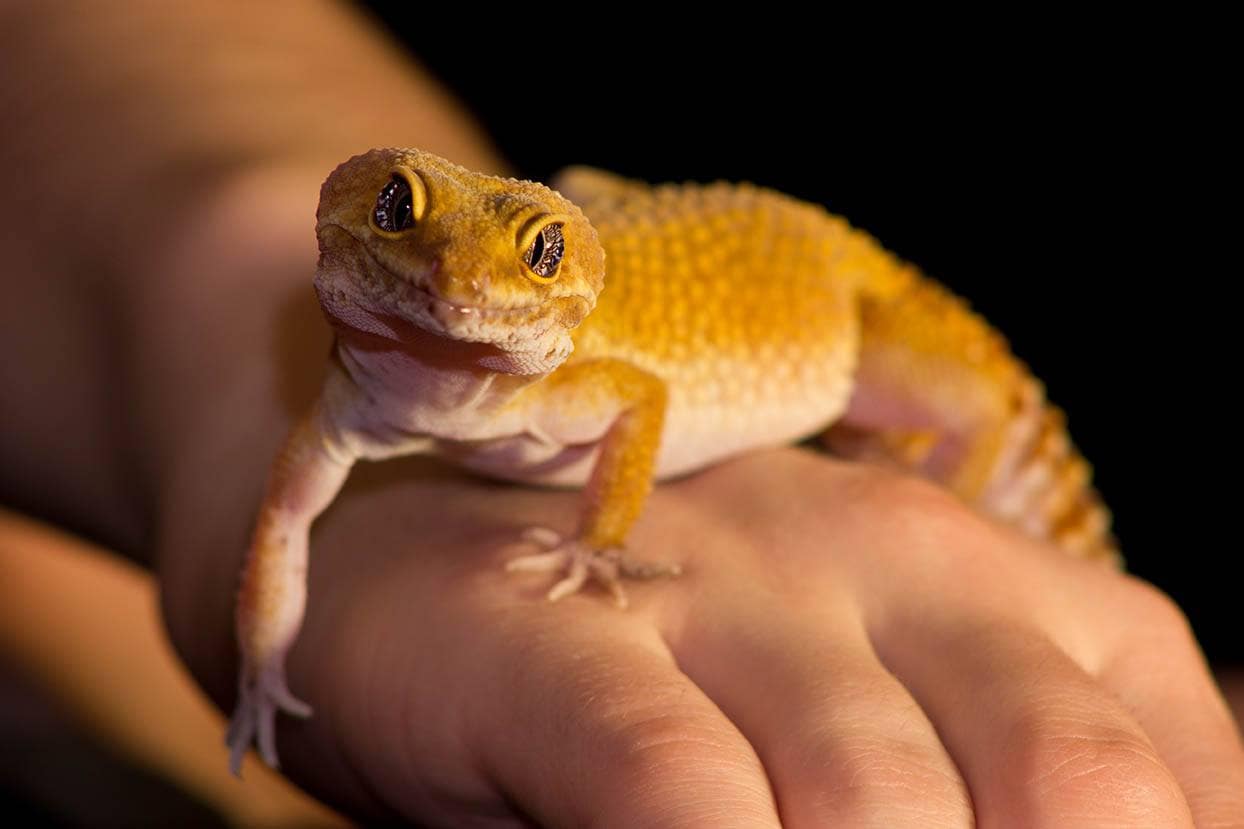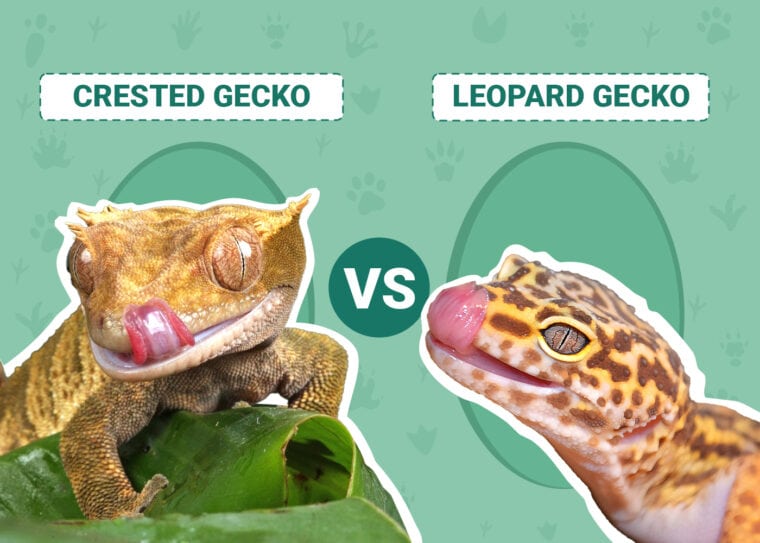
Click to Skip Ahead
If you’re looking for a unique pet-raising experience, you might want to consider a reptile. And geckos are the perfect place to start. There are many different types of gecko varieties available each with its own temperaments and characteristics. But which one is right for you?
New gecko parents are often overwhelmed by the requirements needed when caring for one. That’s why it’s important you stick with an easy-to-raise species if you’re a first-timer. And there are no two better species than the crested gecko and leopard gecko.
Each of these species is much simpler to care for than other geckos due to their relaxed heat, light, and humidity needs. Let’s take a closer look at these two species and determine which one is best for you.

Visual Differences

At a Glance

Crested Gecko Overview

The crested gecko is a very special choice for a pet. And that’s because they were believed to have gone extinct. It wasn’t until 1994 when these lizards were rediscovered. Since their resurfacing, though, their numbers have exploded through advanced breeding programs designed to bring their population back. They have now become increasingly popular as pets and are commonly recommended for novice reptile owners or children learning to care for lizards.
Crested geckos come in many different shades and patterns—also known as morphs. They get their name from a distinct fringed crest that starts above their eyes and runs the length of their bodies. The size of this crest can vary in size from big to small depending on their breeding. However, it’s not their fringed crest that makes them so desirable — it’s their eyelashes. The crested gecko has very ornate and beautiful eyelashes which make them absolutely adorable.
Crested geckos are arboreal geckos, meaning that they’re tree-dwellers. This requires a more complicated terrarium setup than terrestrial lizards. They need to have lots of vertical space and branches to climb. You should keep live vegetation in their habitats as well because they’ll use it for shade and cover.
When it comes to sociability and handling, the crested gecko can be a bit skittish. While they may grow accustomed to their owner, that doesn’t mean they want to be constantly handled. They may nip or bite at you when they’ve had enough. They’re more of a “look, but don’t touch” type of lizard.
Health & Care
Taking care of a crested gecko is going to require some special equipment such as heat lamps, timers, and even misters to provide the proper heat, lighting, and humidity for them. Lighting and heating is the easiest part of caring for them as they thrive in moderate climates. Depending on where you live, you may only need a simple red light bulb for nighttime warmth and lighting.
However, it’s the humidity that can be a bit tricky to handle when it comes to raising a crested gecko. They require moderate to high humidity, so we recommend investing in a quality hygrometer to measure their humidity. There are also great reptile misters and foggers available to help you maintain their delicate balance.

Breeding
One of the reasons it was so easy to bring the crested gecko back from the brink of extinction is because they are such prolific breeders. Even the most novice of reptile keepers can easily breed this species. By simply putting a breeding female and mature male within the same enclosure, you can almost guarantee copulation within a few hours. Females can lay a clutch of two eggs every 30 days during breed season.
With this type of fertility, you may be wondering why the crested gecko almost went extinct in the wild. It has nothing to do with their breeding habits. Deforestation, predation by rodents, and the introduction of the fire ant to their native habitats are what caused their near eradication.
Suitable for:
Crested geckos are great for those looking to enter the world of caring for reptiles. They can provide a good learning experience for those figuring out temperature, lighting, and humidity requirements for more sensitive reptiles. The smallest miscalculation with a crested gecko won’t lead to dire consequences as the species is quite hardy and forgiving. They are also one of the less aggressive gecko species so handling them is entirely possible.
Crested Gecko Related Reads:

Leopard Gecko Overview
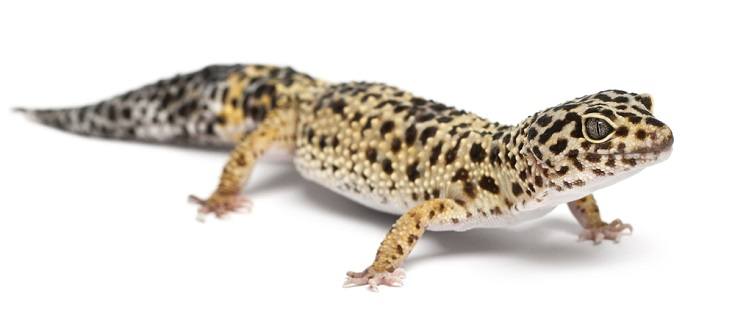
If you’re new to gecko raising, you might want to consider a leopard gecko. They’re chill little lizards who don’t require much and don’t mind being handled as much as other lizards. Of course, each gecko will have its own personality, but leos (as they are commonly called) are pretty laid back.
Leopard geckos get their namesake from their unique spotted appearance. They’ve got light pale, almond-colored skin covered in dark spots. However, that’s just the standard colorway. They can come in all sorts of different shades from pure white to pinkish and yellow hues.
Leos also have a very fat tail which they use to communicate. Slow wagging indicates that they’re relaxed—a state in which you’ll find them most often. And if they rattle their tail at you, it means they’re excited—either to eat or mate. However, if in danger, they can drop their tail to escape. But don’t worry, a new one will grow back, although it can lead to infection, so be attentive if this happens.
The leopard gecko is a desert variety of gecko, and this separates it from other geckos. They aren’t tree climbers and don’t have the necessary sticky footpads to do so. Instead, they dwell on the ground and won’t be seen climbing the walls of their terrarium. Leos are also one of the only gecko species to have distinct outer ears and eyelids due to the need from living in harsh desert environments.
Health & Care
While caring for leopard geckos is considerably easier than most other geckos, they aren’t as simple as taking care of a dog or cat. Geckos—like other reptiles—require special containment systems and precise temperature and humidity requirements. Fortunately, leos don’t need as high of a humidity level as other species, and a simple incandescent bulb can provide enough heat for them.
Breeding
It’s best to keep your leopard gecko separate from other leos—especially if they are of different sexes or multiple males. The males can become quite territorial and will attack one another. Males and females should only be kept together if you plan on breeding them.
Females can lay 8-10 eggs for their first breeding year; however, that number can increase in size as they become more experienced.
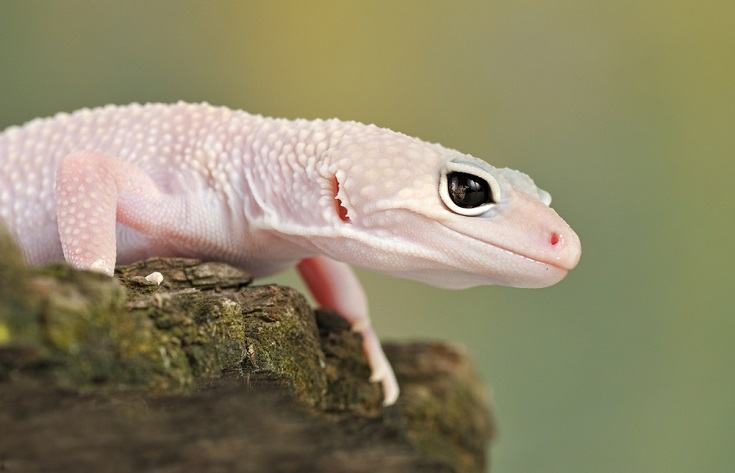
Suitable for:
The leopard gecko is considered by many to be the ideal beginner reptile pet. When compared to other geckos (and reptiles in general), they are among the easiest and low maintenance to care for. Being a desert species, they don’t require high humidity levels and require only simple setups. A basking stone, substrate, a water dish, and a place for them to hide is all that’s needed with their tank.
They are very hardy lizards with fewer sensitivities and health issues than other geckos. Leopard geckos are also relatively docile when compared to other gecko species and can tolerate more handling and socialization than most. If you’re new to caring for reptiles, the leopard gecko is one of the most perfect options.
Leopard Geckos Related Reads:

Which Pet is Right For You?
Each of these two breeds is great for beginners, but which is right for you? If you’re thinking that a gecko would make a great pet but don’t want to delve too deep into the world of herpetology, a leopard gecko could be best for you. They typically don’t mind being handled and require far less than the crested gecko.
However, if you plan on moving up to larger or more sensitive reptiles, a crested gecko may be more your speed. They provide a gentle learning curve to caring for reptiles and are a beautiful addition to any home.
Whichever you choose, you’ll be undertaking a unique pathway when it comes to picking the perfect pet for your family.
Featured Image Credit: Top – No-longer-here, Pixabay | Bottom – torstensimon, Pixabay
